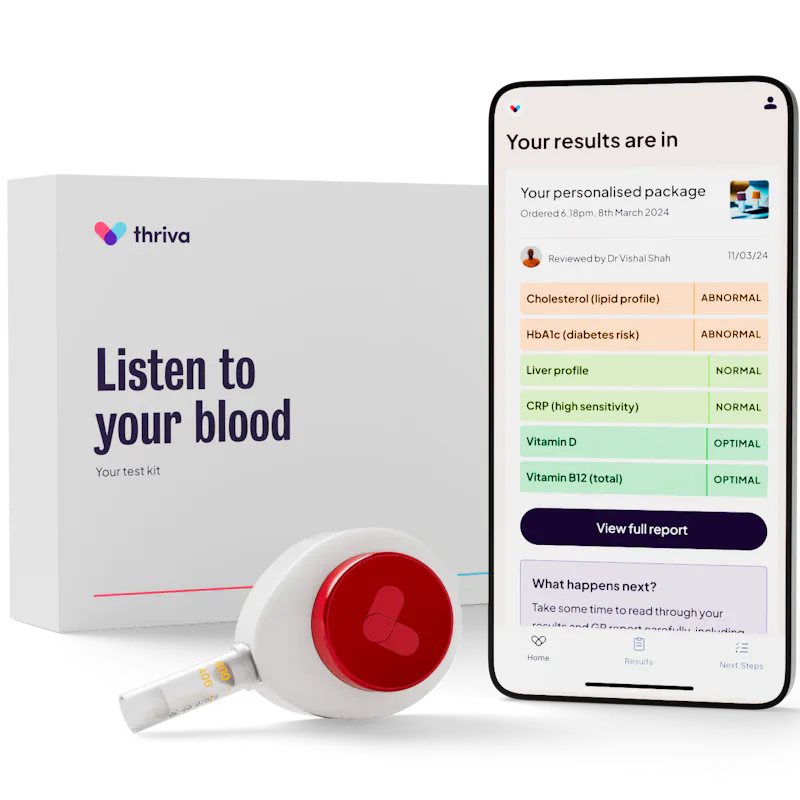Thriva Year in Health Report 2024: How lifestyle changes influence biomarkers



At Thriva, we want to give our users as much insight into their health as possible - and we think community data is a powerful part of that. In 2024 we processed over 30,000 blood tests, and we're excited to showcase some key insights connecting the results to controllable lifestyle factors.
Healthspan, inflammation, and the power of lifestyle choices
Healthspan - the period of life spent in good health - is impacted by various chronic diseases and conditions, which fall into these main categories:
- Cardiovascular disease
- Metabolic disorders, ranging from insulin resistance to diabetes
- Musculoskeletal issues like osteoporosis
- Neurodegenerative diseases such as dementia
What you may not know is that these health conditions are all connected. Central to this connection are inflammation and oxidative stress, which play a critical role in the development and progression of these conditions.
Chronic inflammation - often a result of poor diet or inactivity - can lead to insulin resistance, a hallmark of metabolic disease, and subsequently, diabetes. This same inflammatory process is also associated with atherosclerosis, the underlying cause of many heart diseases.
Oxidative stress occurs when there's an imbalance between free radicals and antioxidants in your body. It plays a significant role in the deterioration of neurons and brain function, leading to neurodegenerative diseases like Alzheimer's.
The lifestyle choices we make have the power to significantly change the outcome of these diseases, meaning our daily actions, including diet, sleep, exercise and stress management, directly influence our healthspan.
Correlation vs Causation
Before moving on to our community stats, let’s first address the difference between correlation and causation.
You can think of correlation like the relationship between ice cream sales and sunburns. They both occur more often in the summer and less often in winter, which means they are correlated. However, selling ice cream doesn't cause sunburns; they're both simply more common in warmer weather.
Any patterns between blood test results and health behaviours may only be a correlation - one is not necessarily causing the other.
Diet and Nutrition
CRP
Our dietary choices can significantly affect our body's inflammatory responses. C-reactive protein (CRP) is a protein in your blood that increases relative to the amount of inflammation in your body, and testing high sensitivity CRP (hs-CRP) can detect lower levels of inflammation that increases your risk of heart disease.
We use the following reference ranges for hs-CRP:
- Less than 1.0 mg/L: low risk of heart disease
- Between 1.0 and 3.0 mg/L: moderate risk of heart disease
- Above 3.0 mg/L: high risk of heart disease
Within our Thriva community, we have found that CRP and diet quality - as rated by you in your health profile - are very much correlated. Shown below is the correlation between users' self-reported diet ratings and the average hs-CRP biomarker result for those users.

Additionally, Thriva users who opt for fruit as a snack had 14% lower CRP (1.87mg/L) compared to those who don't (2.17mg/L). We see higher CRP levels from users reporting biscuits (+14%), crisps (+18%), or chocolate and sweets (+23%) as a snack compared to those who abstain.
The snack we found to have the most positive impact on inflammation was nuts and seeds, leading to 20% lower CRP level (1.80mg/L) compared to those who don’t (2.25mg/L).
Vitamin D
During the winter months, the importance of Vitamin D - a nutrient we derive mainly from sun exposure - becomes particularly pronounced.
Vitamin D plays a crucial role in bone health, immune function and mood. However, the sun’s low angle in winter means that we are unable to produce sufficient Vitamin D from sun exposure.
Our health profile data indicates that 3 out of 5 Thriva users choose to supplement with Vitamin D. Results from blood tests show that users who don’t supplement are three times more likely to have low Vitamin D levels in winter than those who do.
This graph illustrates the difference between those who choose to supplement vs. those who don’t, and highlights the need for proactive measures to ensure adequate intake throughout the winter.

Cholesterol
Apolipoprotein B (ApoB) is a key component of lipoproteins, which transport cholesterol and triglycerides through the bloodstream.
Unlike total cholesterol, which measures all cholesterol content in the blood, ApoB is only present in atherogenic lipoproteins like LDL and VLDL, which are primarily responsible for the deposition of cholesterol in arterial walls, leading to atherosclerosis.
Each LDL and VLDL particle contains a single molecule of ApoB, making it an effective way to count the overall number of these atherogenic particles - and a better indicator of cardiovascular disease risk than other cholesterol markers.
59% of Thriva users had elevated ApoB in 2024, including 18% with a very high level, making it the second most common biomarker out of range for both men and women behind total cholesterol.

Total cholesterol levels were lowest on average in plant-based eaters (4.99 mmol/L), whilst those following a low carb high fat diet had the highest levels (5.97 mmol/L). Similarly, plant-based eaters had the lowest average ApoB (0.97g/L) as well as having the highest percentage of results being within the normal range (59.2%). Remember that this is a pattern within our data, and does not necessarily imply causation.
Exercise
Exercise can be a powerful tool in the fight against inflammation, and users reporting at least 150 minutes of exercise per week had lower hs-CRP levels compared to those reporting less exercise.
This analysis added up the minutes of moderate to high intensity exercise, resistance training and time spent walking from user's health profiles. A hs-CRP level below 3.0 mg/L is considered normal, with below 1.0 mg/L deemed optimal.

Sleep

Thriva's data shows that 24% of individuals reporting a consistent lack of refreshing sleep return high CRP levels (> 3.0 mg/L), compared to only 15% of those who wake up refreshed more frequently (4-7 days).
This trend is also seen for sleep duration, with 24.0% of users reporting 4-6 hours sleep per night having high CRP levels compared to 16.8% of those reporting 6-8 hours sleep.
These figures highlight how sleep is a fundamental pillar of health, profoundly influencing our body's inflammatory responses and overall well-being.
That's a wrap
We hope these community insights inspire you to keep experimenting to see how your next Thriva results respond to changes in your lifestyle. Whether it’s tweaking your diet, adjusting your sleep habits, or finding a more sustainable exercise routine, it’s all about making small, incremental steps towards better health.
Our app is here to guide you with tips backed by solid science, tailored just for you. And if you’re just starting out with us, don't worry – our quiz will help you figure out which tests are right for you.
Anonymised Thriva user data, 2024